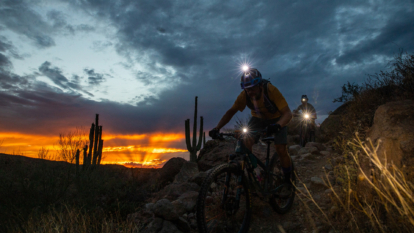Riders of the Night
As temperatures rise in Phoenix, Arizona, mountain bikers are going nocturnal to escape the heat.
Listen to the story
All photos by Andrew Burr
It’s 6:30 p.m. and a mere 112 degrees Fahrenheit when we began pedaling from the South Mountain Park and Preserve, down from 115 degrees just two hours earlier. The trail slogs up a narrow canyon between sunblanched hillsides, the superheated air so thick and stagnant that it almost has substance. No sound disturbs that lifeless heat; even the bugs are silent. My black helmet transfers heat directly to my brain, causing waves of nausea and an instant headache.
Ironically, the misery-inducing conditions are exactly the reason I’m here. It’s June 20, 2024, the longest—and so far, hottest—day of the year here in Phoenix, Arizona, and a fitting start to what will prove to be the hottest summer on record. In 2023, the daily average temperature for all of June, July and August was 97 degrees, and by that September, the weather station at the Phoenix Sky Harbor International Airport had recorded 55 days with highs of at least 110 degrees.
Heat like this isn’t just uncomfortable; it can be downright deadly. In the face of these ever-increasing temps, a new norm has emerged among the area’s mountain bikers: They’ve gone fully nocturnal. In Phoenix, night riding—once reserved for the darker days of winter—has become the only way to ride, and we’re here to experience that adaptation firsthand.
At the moment, however, it isn’t going well. A light breeze is blowing by the time we crest our first ridgeline, but even that doesn’t offer much relief. We’ve been pedaling for less than an hour, but my legs are already wobbly and I’ve downed half my water. It’s still 110 degrees, and I don’t know if I can go much farther.
Then the sun meets the horizon and everything changes.
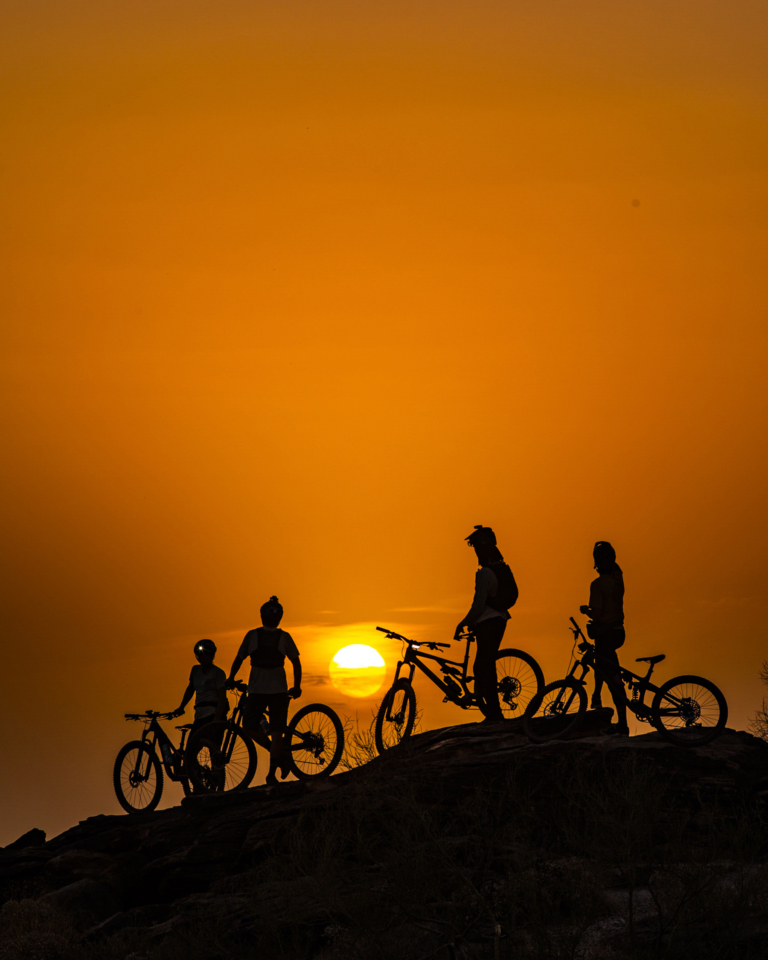
Kait, Kurt, Elliott Milner and Sakeus Bankson pause along the Ridgeline Trail to catch a sunset breeze—a brief respite from the day’s scorching 115-degree temps. This trail is part of Phoenix’s South Mountain Park & Preserve, which covers more than 16,000 acres, stretches 11 miles from east to west and is one of the largest municipal parks in the US.
My first taste of Phoenix summer was earlier that morning in the airport parking garage. A blowdryer-hot gust of wind blasted me as I stepped through the sliding glass doors, and by the time I loaded my bike in the rental truck, I’d already sweat through my shirt.
With over 1.6 million residents, Phoenix is the fifth-largest city in the United States and one of its fastest-growing metropolitan areas, but it’s hard to tell on a 110-plus-degree day. As I drove toward our lodging at the base of South Mountain Park and Preserve, there were almost no humans visible beyond the air-conditioned bustle of traffic. The air shimmered above the blacktop roads, distorting and washing out colors as if the entire city was a mirage. The occasional glimpse of a blissfully blue pool—about a third of the homes in the Greater Phoenix area have them—promised some relief, as did the jarring green of the passing golf courses.
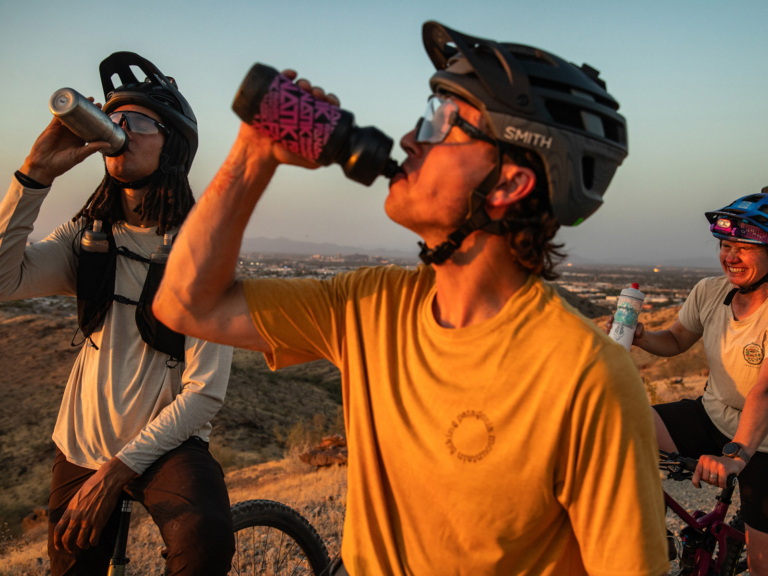
Dehydration can sneak up on you in the desert, especially in 115-degree heat, and the local rule of thumb is to head back to the trailhead before you’re halfway through your water. Elliott, Sakeus and Kait desperately rehydrate after a 7 p.m. climb up the Ridgeline Trail in the South Mountain Park & Preserve.
Half an hour later, I pulled up to the rental house and met my companions for the trip: professional cyclists Kurt Refsnider and Kait Boyle; Tucson-based mountain biker Elliott Milner; photographer Andrew Burr; and videographers Joey Schusler and Kasen Schauman. It was early afternoon and still far too hot to ride (temps had climbed to over 110), so we retreated to the air-conditioned house to discuss the evening’s plans over cold beverages.
During cooler parts of the year, Phoenix is somewhat of a desert mountain junkie’s paradise: Craggy ridges rise in nearly all directions, some climbing 1,000 vertical feet or more directly from the edges of neighborhoods. The area has two of the country’s largest municipal parks, and Trailforks lists nearly 370 miles of singletrack within the larger Phoenix metropolitan area, from wide gravel paths to steep gauntlets of chunky rock tech. This plethora of riding has spawned a quiet but deeply devoted mountain bike community.
A few of us had experienced riding in Arizona: Both Kurt and Kait had previously taught at nearby Prescott College, Kurt as a professor of geology and Kait as an adventure educator, but had only ridden in Phoenix a few times.
Elliott, who graduated from Arizona State University (ASU), has spent years exploring the trails around Phoenix and still occasionally makes the drive from his home base in Tucson to meet up with friends. One of whom is Patrick White, who has been leading a group ride called “Taco Tuesday” every week for nearly seven years.
“We’re pretty religious about it,” says Patrick, who works as a project manager at ASU. “We go all year, no matter the temperature or weather … even when it’s 115 degrees, we’ll still get 10 to 15 people coming out because of how tight-knit the group is.”
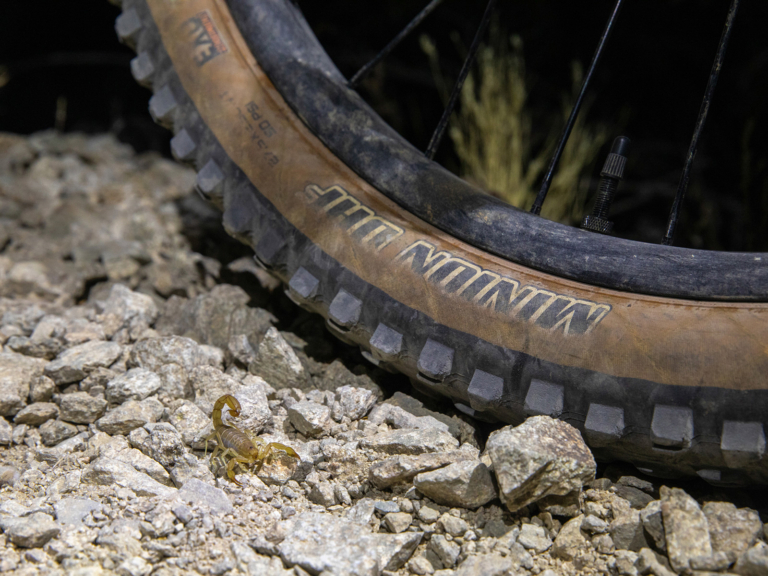
Fun fact: Scorpions glow in the dark. The venomous insects emit a blue-green glow when exposed to ultraviolet light such as that cast by the moon, making it a particularly eerie sight in the desert darkness.
It was hard to imagine such a vibrant community when we began our ride that evening at 6:30 p.m. The South Mountain trailhead felt long abandoned, without a hint of a breeze to stir the withered dunbrown hillsides, and after 45 minutes of climbing, the situation seemed just as bleak.
Until the sun drops below the mountains to the west, that is.
Over the next 30 minutes, temps plunge 10 degrees, and a wave of life washes over the landscape. Birds chirp as they flit between the tops of saguaro cacti and bats dart silently against the cobalt sky, chasing the bees and bugs that are suddenly buzzing in the cool air. A riot of subtle color springs up across the hillside, and a breeze carries the smell of dew on dust and the bitter nip of creosote bushes.
Night seems to bring new life to the city as well. A vast twinkling web wraps around the blank hulk of the mountains below us, the lights spilling across the valley from east to west and stretching into the distance as far as we can see.
We take a few moments to absorb the view, then polish off the last drops of water, click on our lights and prepare to plunge into darkness.
A few minutes later, we stop to shoot photos on a particularly rocky section and three groups of bikers come flying by, lights blazing as they navigate the chunky terrain with obvious familiarity. The trail doesn’t feel crowded, however—at least not with humans. We may only be a few miles from the nearest golf course, but our lights reveal a whole menagerie of wildlife.
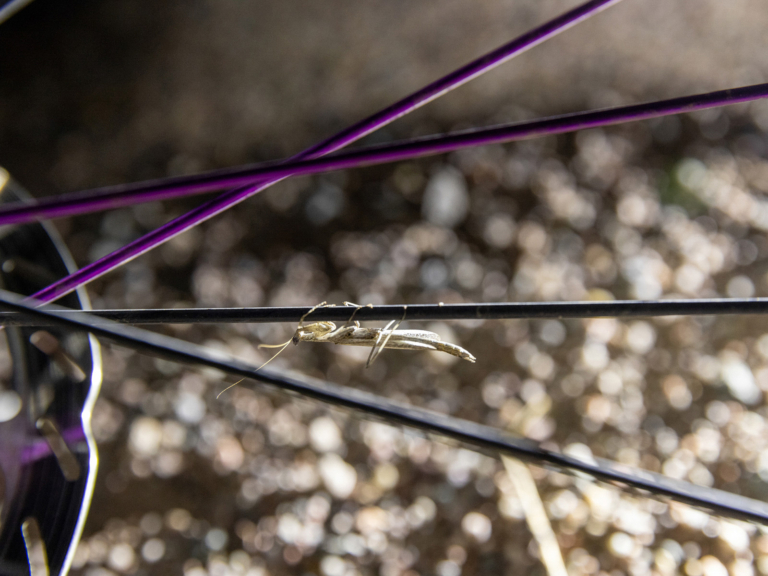
While this praying mantis was the only wildlife that tried to catch a ride, it was just one of a menagerie of critters we saw including deer, lizards, spiders, toads and even a few javelinas, a dog-sized animal that resembles a wild boar.
“Night riding is a way to experience the landscape in a different state, one that we, as domesticated humans, tend to miss,” says Kait. “At night, the environment is totally different. A whole different world wakes up.”
Jackrabbits zigzag down the trail at breakneck speed, startling emerging desert mice. Scorpions scamper across the sand, and at one point, a chubby gecko wiggles its way across the top of a berm. Fresh deer tracks churn up the sand at one trail crossing, and unseen sounds from deeper in the brush hint at larger animals hidden in the dark.
“If you’ve never heard the yaps of coyotes at night, it is the wildest sound and most surreal thing to experience on a ride,” Patrick says. “You feel a little nervous, like, ‘Oh man, I hope they’ve found dinner.’”
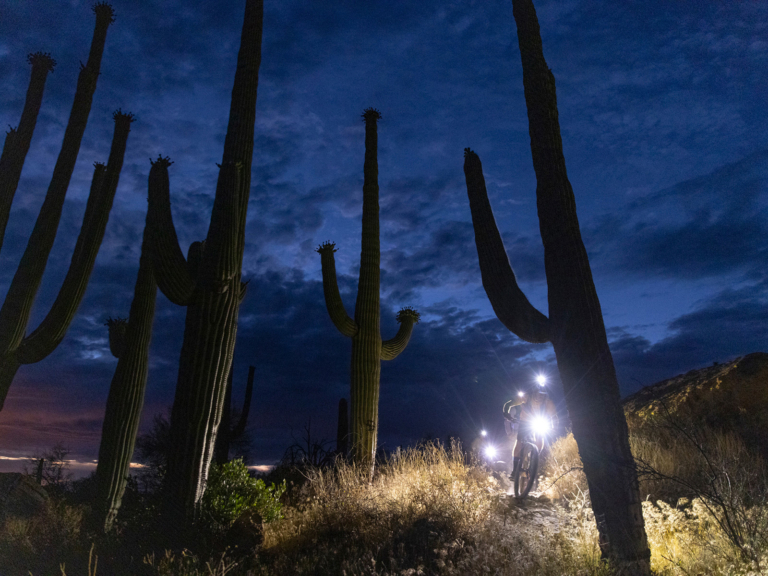
I’ve never wanted to hug a cactus until I saw my first saguaro. Covered in 2-inch thorns, they can grow to 50 feet tall, weigh nearly 2 tons and live to be over 150 years old. They won’t sprout their distinctive arms—which can number in the dozens—until they’re over 60. Kait, Elliott and Kurt among the spines on the Arizona National Scenic Trail.
The next morning we set off at 3:30 a.m., pedaling through a subdivision toward South Mountain. Early morning is technically the coolest part of the day, and the current 98-degree temp is indeed the lowest we’ve experienced so far. But rather than feeling brisk, the waves of heat radiating from the blacktop bake my legs worse than yesterday’s sun. We reach singletrack just as my feet start sweating, and within 50 feet, it feels a dozen degrees cooler.
I ask Dr. Erinanne Saffell about this a few hours later, as we’re sitting in her office at ASU in Tempe. Born and raised in the Phoenix area, Dr. Saffell is the Arizona State Climatologist, director of the Arizona State Climate Office and an associate professor at ASU. As an expert on extreme weather events, she advises on long-term weather trends in the state.
What we’d experienced that morning, she tells us, is something called the “urban heat island,” where urban infrastructure absorbs and holds solar heat throughout the day. Phoenix has one of the world’s largest magnitude urban heat islands, meaning that at night it can get 10 to 14 degrees cooler in rural versus urban areas.
“It’s not that it’s necessarily making temperatures hotter during the day,” Dr. Saffell explains. “But that sunlight is stored by our blacktop asphalt and our cement sidewalks and our buildings, and then released very slowly at night, so our nighttime temperatures aren’t cooling off as effectively as they used to.”
It is important to remember that the Four Corners region needs a hot June; the annual monsoons, a critical source of precipitation for Phoenix, depend on those high temps. But now the city experiences nearly five times the number of 110-degree days—over 20 a year—as they did in the early 1900s, which saw about five a year. In 2023, that number jumped to 55.
“I think what we provide is context,” she says. “Here in the Phoenix metro area, we can look at the numbers as far back as 1895. So, one of the things I look at is, ‘Is this normal for it to be 110 degrees?’”
Few people have experienced the impacts of extreme heat more directly than Phoenix Fire Department Captain John Shumaker. He’s been riding and racing mountain bikes in the Phoenix area since the late 1980s and has spent two decades saving people on the same trails. Each year, more than 200 people are rescued from Maricopa County parks and preserves; some get lost, some injured, some just “run out of gas somewhere in the middle of nowhere,” John says.
Whatever the cause, John and his coworkers are the ones tasked with pulling them to safety, which is another reason to ride at night. It’s not only safer for you; it’s safer for those who come to save you if you have an accident. After a multi-incident day put three rescuers in the hospital, the city began closing trails on Piestewa Peak and Camelback Mountain whenever the National Weather Service issued an excessive heat warning.
“We’ll come regardless of the time of day and temp,” John says. “We hope we have helicopter access, but sometimes we just have to put boots on the ground and go get you. When that means hiking up some of these mountains in 110-degree temperatures, that’s a tremendous amount of time and wear and tear on our folks.”
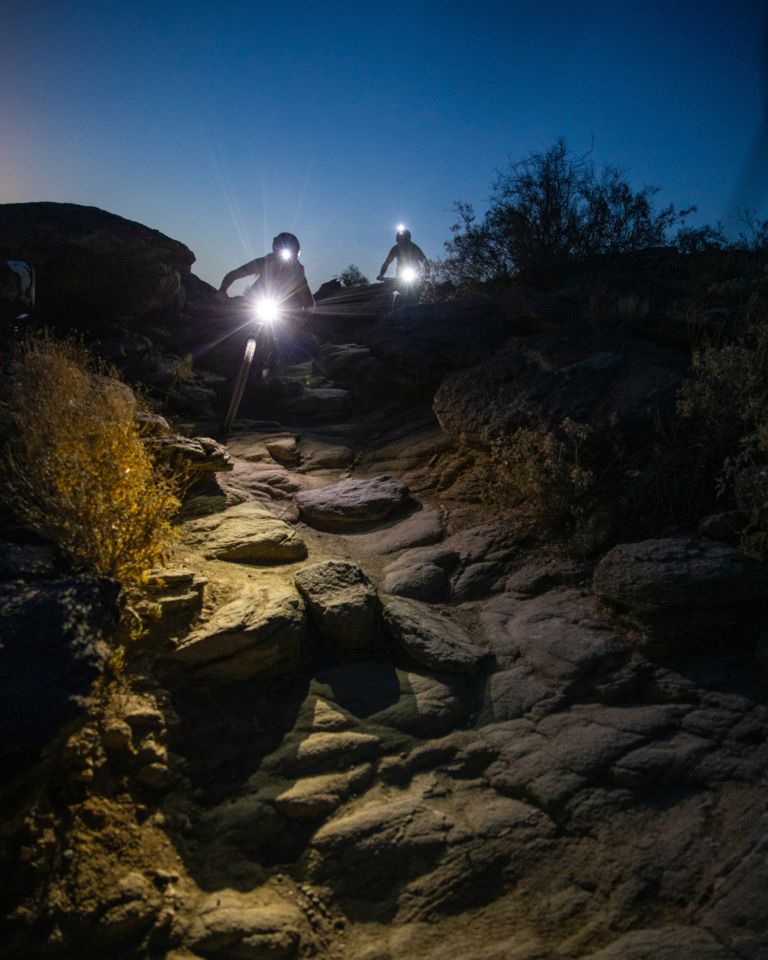
The Mormon Trail rises directly from a blacktopped cul-de-sac in southern Phoenix, and though it’s only 100 feet from asphalt to singletrack, the temperature on the trail can be 10 degrees cooler. Kait and Sakeus navigate a chunky section at 4:30 a.m.; an hour later, the temps were already nearing 100 degrees.
It’s our final evening in Phoenix and we’ve decided to ride National, the marquee descent at South Mountain. The trail is picturesque, a sandy ribbon winding through flowering barrel cacti and towering saguaros, and for some reason it fills me with rage.
At first, I have no idea why. Then I remember it’s 118 degrees out and I’m slowly baking alive.
It’s hard to get excited for anything, much less a trail, when the air is hot enough to melt wax, but with each pedal stroke we get closer to the top of the climb and the sun gets closer to the horizon. When we finally reach the ridgeline above the city, we’re treated to a truly wonderful dose of wind and views of a dust storm, monsoon lightning and a sizeable structure fire in the distance. The breeze feels downright frigid against my sweaty jersey.
At 7:15 p.m., the temp is hovering just below 110 and the light on the mountaintops has turned from brittle yellow to honey gold. Around us is a forest of saguaros, the densest we’ve seen in the preserve, and the crowns of yellow flowers topping each pillar add an even more comical air to their iconic silhouettes.
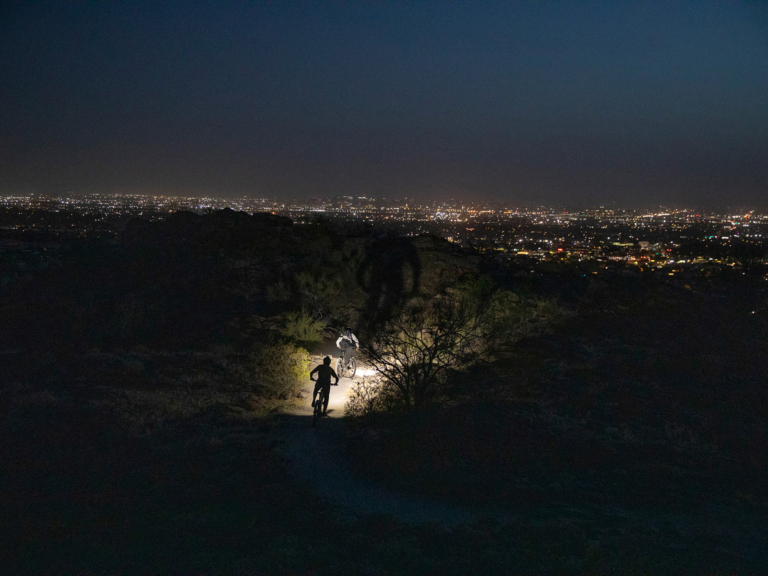
Elliott and Sakeus take in the city lights on Upper Javelina Canyon. Night riding is a stunning way to see the sheer size of Phoenix, which encompasses 1.6 million people, and—despite limited water and scorching summer heat—is one of the fastest growing cities in the country.
Water bottles nearing empty, we settle in to wait out the heat and watch the world turn from yellow to gold to pink in the superheated evening light. A jackrabbit stretches itself out on its belly just off the trail, which I later learn is a cooling method. Despite our proximity, the rabbit doesn’t move. When it’s this hot your priorities change, whatever the species.
The descent is the wildest of the trip, navigating boulder-packed chutes and chunky rock gardens as the trail zigzags off the ridge and back into the canyon. Shadows give the scene an eerie feel, but also add a sense of texture that unlocks even the most difficult sections.
At the trailhead, we immediately flop down next to the vehicles and spend the next half-hour hydrating with a mix of water, Gatorade and icy Mexican lagers. A commotion in the bushes reveals a large javelina—a pig-like ungulate native to the Southwest—being chased by a dubious-looking figure on an electric scooter. Oh, Arizona.
As we’re leaving the lot, headed to In-N-Out for milkshakes, two more bike-loaded trucks pull in. It’s 10:30 p.m. and the locals know it’s the perfect time to start their ride.
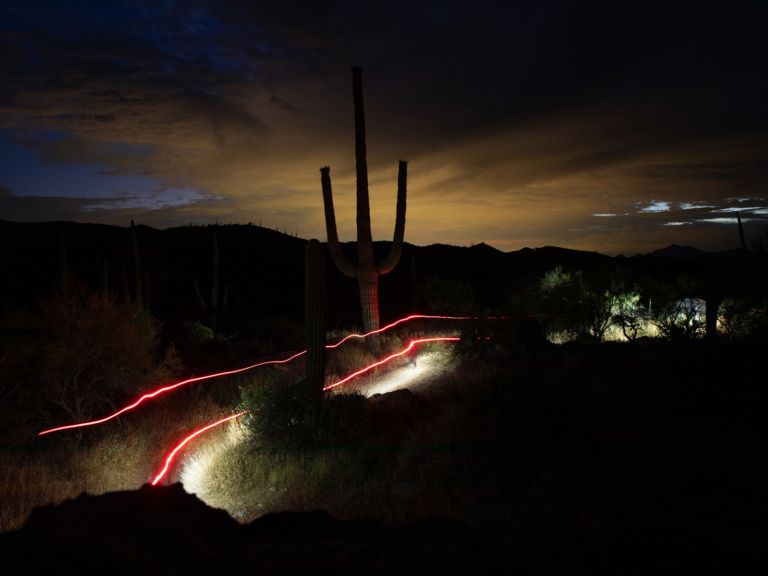
The Picketpost trailhead is an hour’s drive from downtown Phoenix, but the city still lights up the horizon. The crew zooms by a rare symmetrical saguaro on their way back to the trucks (and burritos), taking care not to run over the horde of toads that covered the trail a few hours after sunset.
